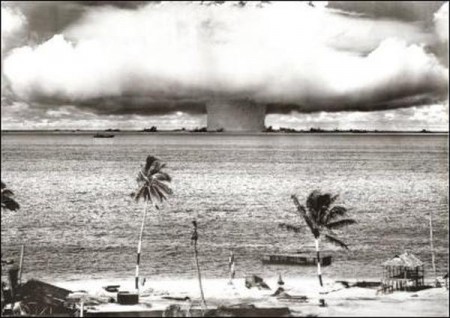A nuclear weapon is an explosive device that derives its destructive force from nuclear reactions, either fission (fission bomb) or a combination of fission and fusion (thermonuclear weapon). Both reactions release vast quantities of energy from relatively small amounts of matter. The first fission (“atomic”) bomb test released the same amount of energy as approximately 20,000 tons of TNT. The first thermonuclear (“hydrogen”) bomb test released the same amount of energy as approximately 10,000,000 tons of TNT.
A thermonuclear weapon weighing little more than 2,400 pounds (1,100 kg) can produce an explosive force comparable to the detonation of more than 1.2 million tons (1.1 million tonnes) of TNT. A nuclear device no larger than traditional bombs can devastate an entire city by blast, fire, and radiation. Nuclear weapons are considered weapons of mass destruction, and their use and control have been a major focus of international relations policy since their debut.
Nuclear weapons have been used twice in nuclear warfare, both times by the United States against Japan near the end of World War II. On August 6, 1945, the U.S. Army Air Forces detonated a uranium gun-type fission bomb over the Japanese city of Hiroshima; three days later, on August 9, the U.S. Army Air Forces detonated a plutonium implosion-type fission bomb codenamed “Fat Man” over the Japanese city of Nagasaki. The bombings resulted in the deaths of approximately 200,000 civilians and military personnel from acute injuries sustained from the explosions. The ethics of the bombings and their role in Japan’s surrender remain the subject of scholarly and popular debate.
Since the atomic bombings of Hiroshima and Nagasaki, nuclear weapons have been detonated on over two thousand occasions for the purposes of testing and demonstration. Only a few nations possess such weapons or are suspected of seeking them. The only countries known to have detonated nuclear weapons—and acknowledge possessing them—are (chronologically by date of first test) the United States, the Soviet Union (succeeded as a nuclear power by Russia), the United Kingdom, France, the People’s Republic of China, India, Pakistan, and North Korea. Germany, Italy, Turkey, Belgium and the Netherlands are NATO nuclear weapons sharing states.
Israel is also believed to possess nuclear weapons, though in a policy of deliberate ambiguity, it does not acknowledge having them. One state, South Africa, fabricated nuclear weapons in the past, but as its apartheid regime was coming to an end, it disassembled its arsenal, acceded to the Nuclear Non-Proliferation Treaty, and accepted full-scope international safeguards.
Following the fall of the Soviet Union, the former Soviet republics of Belarus, Kazakhstan and Ukraine inherited nuclear weapons. They were all transferred to Russia. The Federation of American Scientists estimated there were more than 15,700 nuclear warheads worldwide as of 2015, with around 4,100 of them considered “operational” (ready for immediate use).
Visits: 76



